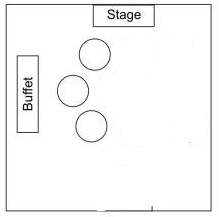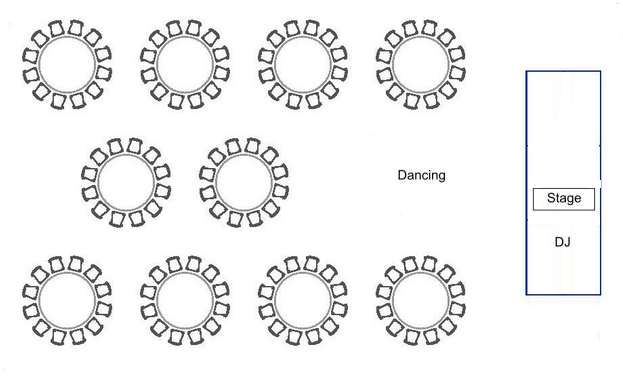Introduction
The main purpose of the banquet organised in the Cape Bretoner Room is the social entertaining and private celebration. The function of the banquet is a dinner that is preceded by the cocktail reception and followed by the dance with DJ and open bar. The banquet is expected to combine such types of meals as the official reception with appetizers and the sit-down banquet with four courses. The banquet planning depends on the whole number of guests and the number of expected children.
Beverages for the Stand up Reception
The stand up cocktail reception with six types of appetizers is expected to last one hour (6.00pm – 7.00pm). Four types of beers are proposed for the reception, and the whole number of bottles is 45. The assortment of the proposed beers includes pale ale, light, and dark sorts of the beer for guests. The overall cost of the beer for the stand up reception is about $165. Four types of alcohol cocktails are proposed for guests, including Margarita, Pina Colada, Manhattan, and Gin and Tonic. These mixed drinks are prepared by a barman. The overall cost for cocktails will depend on the price of the components for mixing the cocktails. The expected price is about $150.
Children will be proposed to test such mocktails as Shirley Temple and Mint Choco Mocktail. The cost for mocktails depends on the price of the used components, and it is expected to be about $50. The assortment of soft drinks is also proposed to children and for those persons who prefer to drink non-alcoholic beverages. The list includes lemonade, coke products, iced tea, fruit water, and bottled water. The overall cost planned for the soft drinks is about $54.
The quests will also be proposed red wine (Merlot) and white wine (Chardonnay) that support the tests of the appetizers for the stand up reception. The necessary number of bottles with wine is determined with the focus on the fact that 12 bottles are usually proposed for 72 guests. Paying attention to the number of children among guests, it is relevant to order 6 bottles of red wine and 7 bottles of white wine for the reception. The provided beverages and the listed number of bottles do not include the beverages proposed to guests after the dinner (Table 1).
Table 1. List of Beverages for the Reception
Appetizers for the Reception
The proposed appetizers for the reception are selected depending on the number of children, vegetarians, and persons with peanut allergy among the guests. Such a hot appetizer as Cheese Stuffed Mushrooms is appropriate for vegetarians, children, and a person with allergy because it includes the light cream cheese and ecologically safe mushrooms. The other hot appetizer is Skewered Chicken with Parmesan that can be tested by the person with allergy, children, and other guests, not including vegetarians. Hot Smoked Salmon with Cream Cheese is mainly proposed for adult guests, not including vegetarians because of the use of smoked salmon that is not appropriate for children and persons who do not eat meat and fish.
Two types of cold appetizers, including Flatbreads with Spinach and Goat Cheese and Artichoke with Parmesan and Tomato Sauce can be eaten by children and vegetarians because their main components are vegetables and cheese. Chilled Prawns can be tested by all adult guests, not including vegetarians. All the hot and cold appetizers can be eaten by the guest with the peanut allergy because the elements of peanut are not presented in dishes. The assortment of fruits is displayed additionally on large plates. The list of appetizers and prices for a dozen are presented in Table 2.
Table 2. List of Hot and Cold Appetizers for the Reception
The Banquet Menu
The banquet is served as a sit-down with four courses ordered by the client. The quests are proposed soup as the first course, the salad as the entree, the main course, and the dessert. The variants of the menu for vegetarians and children are also proposed in order to meet the guests’ specific expectations and needs. The final four-course menu for the sit-down banquet is presented as Figure 1.
Figure 1. The Four-Course Menu for the Banquet
The detailed list including the recipes of the courses, necessary components, and possible prices is provided in Table 3. The amount of necessary products is determined depending on the number of portions for vegetarians, children, and adult guests. In spite of the fact that the menu for children and vegetarians is the same as for the other guests, the recipes are modified to address the needs of these groups of guests and propose light versions of courses that do not include components of the animal products. The variants of the menu that are proposed for children can vary depending on their age and consumption of clams or prawns controlled by parents.
Table 3. Courses Recipes and Prices
Equipment Needed for the Banquet
The equipment needed for the banquet includes tables for adult guests and children, chairs, linen, chinaware, glassware, silverware, and equipment for the further dance (Strianese & Strianese, 2003, p. 112). Round tables can be discussed as appropriate for the expected type of the banquet. Needed tables are of different sizes in order to place 83 guests including 16 children appropriately (Strianese & Strianese, 2003, p. 90). Linen, chinaware, glassware, and silverware are determined and listed with the focus on unpredictable events (broken glass) (Table 4).
Table 4. List of Equipment Needed for the Banquet
The Banquet Event Order
It is planned that the Reception will last only one hour. During this period of time, the banquet manager will ensure that all the invited guests are present. The sit-down banquet with four courses will follow the Reception. During this period, the organizers of the banquet are expected to perform their speeches in front of the guests in order to thank them for coming and sharing the joy of celebration. The projectors are expected to be used for demonstrating the photo material. In order to ensure that all the guests feel comfortable, the Classical Banquet style for setting up the guests is chosen. The dinner will be followed by the dance session with the invited DJ and open bar (Strianese & Strianese, 2003, p. 112). The podium can serve as a kind of stage of the DJ. The detailed Banquet Event Order is provided in Table 5.
Table 5. Banquet Event Order
The Floor Plan for the Entire Function
The proposed floor plans demonstrate the table layout for the Reception and for the sit-down banquet. The presence of the podium or stage is important in order to place the DJ, the projector, and specific screens necessary to provide the photo material and to focus the attention of the guests on the speakers. The podium is expected to be organised in the part of the room that is far from the entrance. For the Reception, it is expected to use only three tables and the station used as the buffet, as it is in Figure 2. Ten round tables are planned to be in the centre of the room according to the Classical Banquet style in order to place the large number of guests during the banquet part of the celebration. Figure 3 provides the example of setting the tables in the room in order to make all the guests comfortable. The central part of the room near the podium can be effectively used for dancing after the dinner as it was planned by the client (Strianese & Strianese, 2003, p. 114). This room can also be used for setting the Reception, but the number of tables should be different.


Example of the Place Setting for One Guest
Figure 4 represents the example of setting the place for one guest while following the American service method. It is important to pay attention to serving several plates for the first course and second courses. Much attention should be paid to providing all the necessary silverware that is appropriate for different types of courses and dessert. The separate plate for the bread should also be provided along with a knife. Services persons are expected to pay much attention to providing the appropriate glassware while focusing on the fact that the main course is served with the wine and the dessert is served with champagne. It is also appropriate to provide the place cards for the guests in order to be sure that all the guests are placed properly and according to the provided number of tables and chairs, that are listed in the Banquet Event Order.

Staff and Position Description
The approach to staffing the front of the house depends on the number of guests and the service type and method. If the American service is used, it is relevant to adopt the combination service method for serving more than 80 persons because this method includes the features of the station and follow-up methods. Thus, the minimal number of service persons can effectively serve more than 80 guests while being assigned to different tables and being responsible for providing the services for the other tables depending on the need or request. Thus, four service persons are expected to be assigned to their tables depending on the following scheme:
- 1 server – 3 tables (8 guests each);
- 1 server – 3 tables (8 guests each);
- 1 server – 2 tables (10 guests each);
- 1 server – 2 tables for children (8 guests each).
One head banquet waiter is expected to control and coordinate the work of service persons (Rolke, 2009, p. 54). The head banquet waiter is also responsible for seating guests in the room. The bar will be open during the Reception part and after the dinner during the DJ session. Two barmen or bartenders are expected to serve the guests (Andrews, 2013, p. 31).
The position of the server or the service person includes the following responsibilities:
- Service persons are expected to serve the food and change the courses according to the rules of the American service (Chon & Yu, 2012, p. 81).
- Service persons are responsible for setting the tables before the guests come (Andrews, 2013, p. 28; Chon & Yu, 2012, p. 76).
- Service persons ensure that the guests have all the necessary utensils and glassware.
- Service persons ensure to meet the guests’ expectations and needs (Chon & Yu, 2012, p. 78).
- Service persons are responsible for removing the glasses and plates for cleaning (Andrews, 2013, p. 28).
- Service persons are responsible for decorating dishes in preparation for serving the tables.
- Service persons are responsible for filling salt, pepper, sugar, and napkin containers (Andrews, 2013, p. 29; Chon & Yu, 2012, p. 76).
Conclusion
The paper provides the plan for organising the banquet of the dinner or celebration function for 83 guests, including children. Much attention is paid to describing the proposed appetizers and to designing the menu for all the guests, including children and vegetarians. The menu is proposed according to the banquet function and the ordered number of courses. The developed Banquet Event Order includes all the necessary information on the organisation of the event, with concentrating on the time, location, menu, and labour required to provide the efficient services for the guests. The specific responsibilities of servers working at the banquet are also described in detail.
References
Andrews, S. (2013). Food and beverage service: A training manual. New York, NY: Tata McGraw-Hill Education.
Chon, K. S., & Yu, L. (2012). The international hospitality business: Management and operations. New York, NY: Routledge.
Rolke, A. (2009). Remarkable service: A guide to winning and keeping customers for servers, managers, and restaurant owners. New York, NY: John Wiley & Sons.
Strianese, A., & Strianese, P. (2003). Dining room and banquet management. New York, NY: Thomson/Delmar Learning.